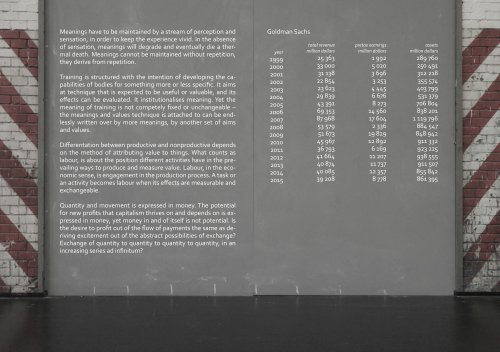SODA WORKS 2016
The SODA (Solo/Dance/Authorship) class of 2017 have compiled this publication to contain selected content from their individual thesis projects. It is the aim of the publication to present a selection of artist work books, documentations of creative processes and presentations of independent research areas for public dissemination.
The SODA (Solo/Dance/Authorship) class of 2017 have compiled this publication to contain selected content from their individual thesis projects. It is the aim of the publication to present a selection of artist work books, documentations of creative processes and presentations of independent research areas for public dissemination.
Create successful ePaper yourself
Turn your PDF publications into a flip-book with our unique Google optimized e-Paper software.
Meanings have to be maintained by a stream of perception and<br />
sensation, in order to keep the experience vivid. In the absence<br />
of sensation, meanings will degrade and eventually die a thermal<br />
death. Meanings cannot be maintained without repetition,<br />
they derive from repetition.<br />
Training is structured with the intention of developing the capabilities<br />
of bodies for something more or less specific. It aims<br />
at technique that is expected to be useful or valuable, and its<br />
effects can be evaluated. It institutionalises meaning. Yet the<br />
meaning of training is not competely fixed or unchangeable –<br />
the meanings and values technique is attached to can be endlessly<br />
written over by more meanings, by another set of aims<br />
and values.<br />
Differentation between productive and nonproductive depends<br />
on the method of attributing value to things. What counts as<br />
labour, is about the position different activities have in the prevailing<br />
ways to produce and measure value. Labour, in the economic<br />
sense, is engagement in the production process. A task or<br />
an activity becomes labour when its effects are measurable and<br />
exchangeable.<br />
Goldman Sachs<br />
year<br />
1999<br />
2000<br />
2001<br />
2002<br />
2003<br />
2004<br />
2005<br />
2006<br />
2007<br />
2008<br />
2009<br />
2010<br />
2011<br />
2012<br />
2013<br />
2014<br />
2015<br />
total revenue<br />
million dollars<br />
25 363<br />
33 000<br />
31 138<br />
22 854<br />
23 623<br />
29 839<br />
43 391<br />
69 353<br />
87 968<br />
53 579<br />
51 673<br />
45 967<br />
36 793<br />
41 664<br />
40 874<br />
40 085<br />
39 208<br />
pretax earnings<br />
million dollars<br />
1 992<br />
5 020<br />
3 696<br />
3 253<br />
4 445<br />
6 676<br />
8 273<br />
14 560<br />
17 604<br />
2 336<br />
19 829<br />
12 892<br />
6 169<br />
11 207<br />
11 737<br />
12 357<br />
8 778<br />
assets<br />
million dollars<br />
289 760<br />
250 491<br />
312 218<br />
355 574<br />
403 799<br />
531 379<br />
706 804<br />
838 201<br />
1 119 796<br />
884 547<br />
848 942<br />
911 332<br />
923 225<br />
938 555<br />
911 507<br />
855 842<br />
861 395<br />
Quantity and movement is expressed in money. The potential<br />
for new profits that capitalism thrives on and depends on is expressed<br />
in money, yet money in and of itself is not potential. Is<br />
the desire to profit out of the flow of payments the same as deriving<br />
excitement out of the abstract possibilities of exchange?<br />
Exchange of quantity to quantity to quantity to quantity, in an<br />
increasing series ad infinitum?


















